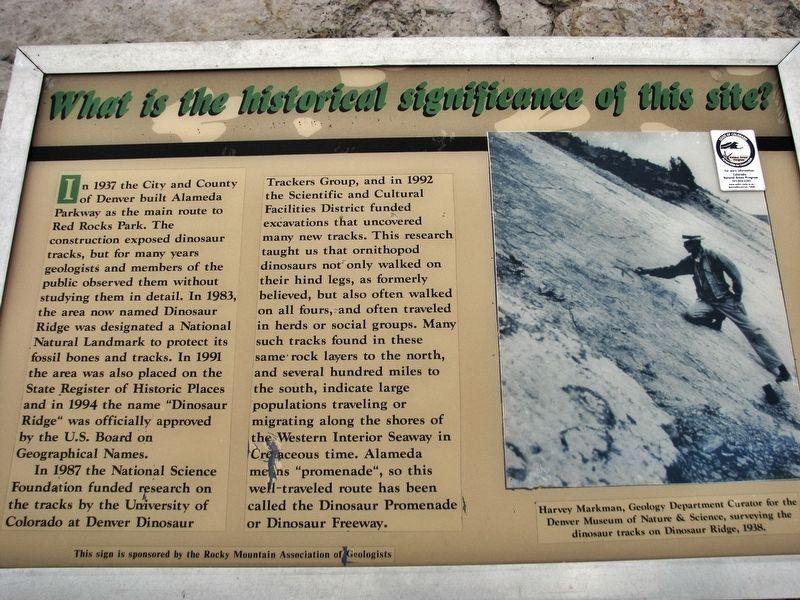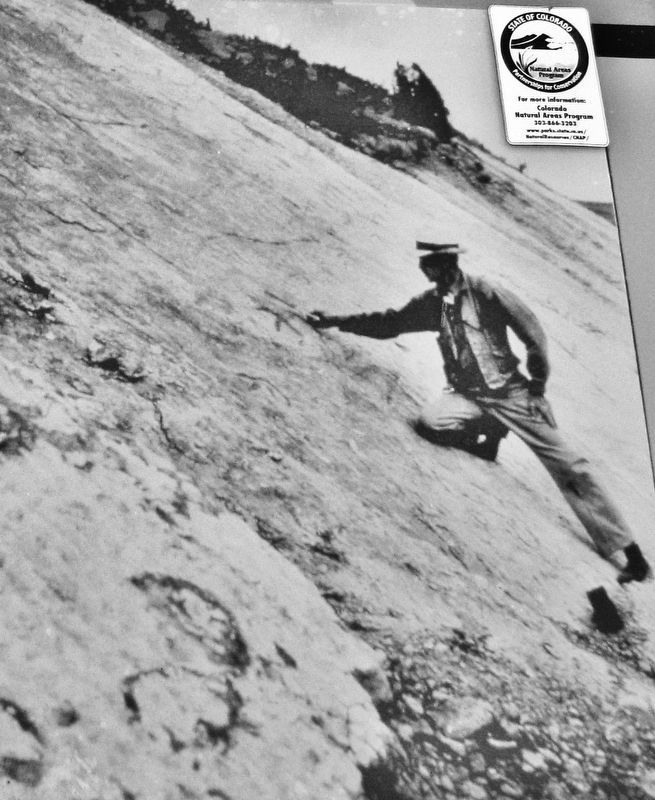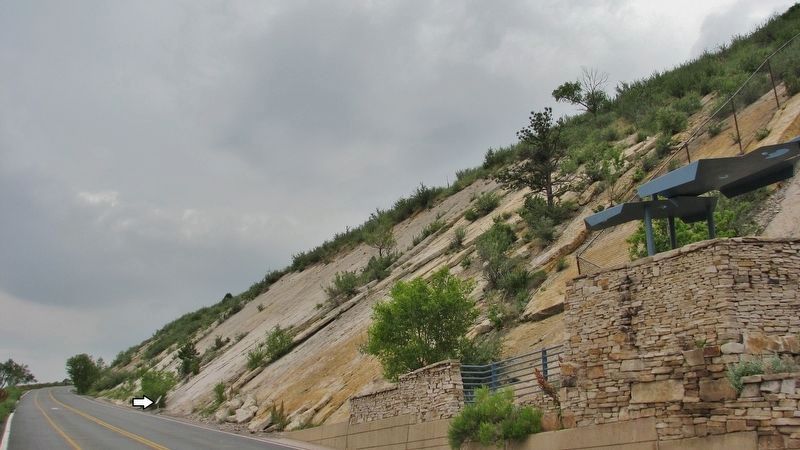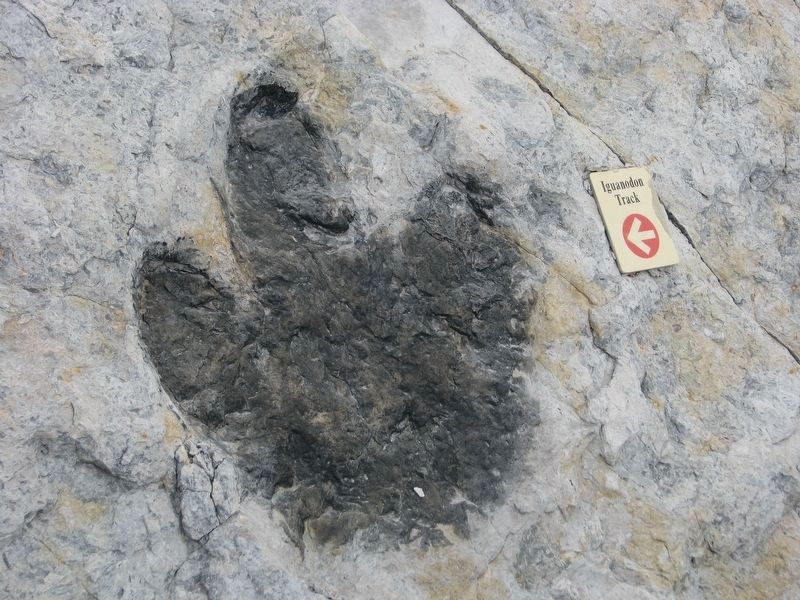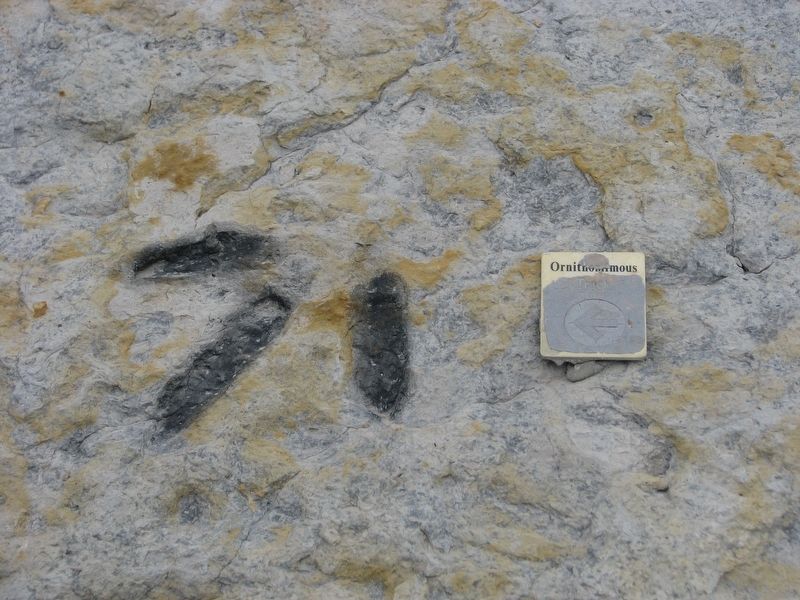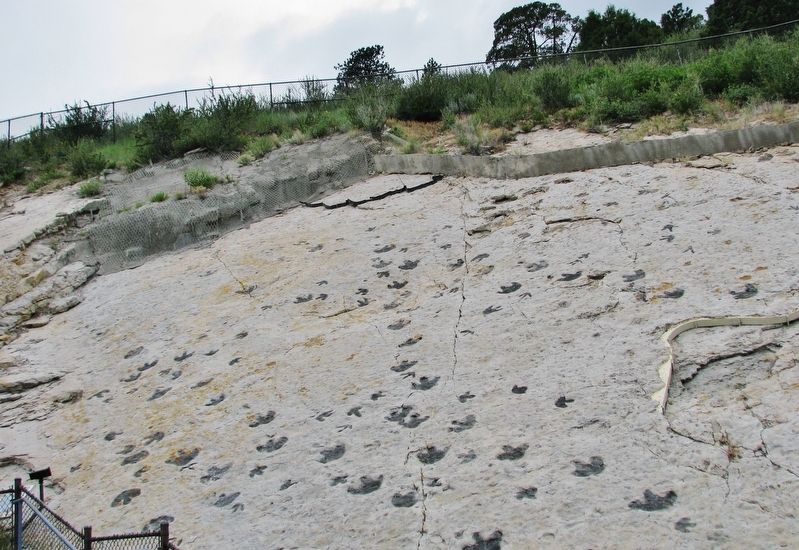Morrison in Jefferson County, Colorado — The American Mountains (Southwest)
What is the Historical Significance of this Site?
Inscription.
In 1937 the City and County of Denver built Alameda Parkway as the main route to Red Rocks Park. The construction exposed dinosaur tracks, but for many years geologists and members of the public observed them without studying them in detail. In 1983, the area now named Dinosaur Ridge was designated a National Natural Landmark to protect its fossil bones and tracks. In 1991 the area was also placed on the State Register of Historic Places and in 1994 the name "Dinosaur Ridge" was officially approved by the U.S. Board on Geographical Names.
In 1987 the National Science Foundation funded research on the tracks by the University of Colorado at Denver Dinosaur Trackers Group, and in 1992 the Scientific and Cultural Facilities District funded excavations that uncovered many new tracks. This research taught us that ornithopod dinosaurs not only walked on their hind legs, as formerly believed, but also often walked on all fours, and often traveled in herds or social groups. Many such tracks found in these same rock layers to the north, and several hundred miles to the south, indicate large populations traveling or migrating along the shores of the Western Interior Seaway in Cretaceous time. Alameda means "promenade", so this well-traveled route has been called the Dinosaur Promenade or Dinosaur Freeway.
Erected by Rocky Mountain Association of Geologists.
Topics. This historical marker is listed in these topic lists: Paleontology • Parks & Recreational Areas • Roads & Vehicles • Science & Medicine. A significant historical year for this entry is 1937.
Location. 39° 40.823′ N, 105° 11.531′ W. Marker is in Morrison, Colorado, in Jefferson County. Marker is on West Alameda Parkway/Dinosaur Ridge, half a mile south of South Rooney Road (County Road 53), on the right when traveling south. Marker is located just south of the Dinosaur Track Site on Dinosaur Ridge. Touch for map. Marker is in this post office area: Morrison CO 80465, United States of America. Touch for directions.
Other nearby markers. At least 8 other markers are within walking distance of this marker. Theropod Track (approx. 0.2 miles away); Morrison Fossil Area (approx. 0.2 miles away); Late Jurassic Time (approx. 0.2 miles away); Rock Deformation (approx. 0.2 miles away); Brontosaur Bulges (approx. 0.2 miles away); Volcanic Ash (approx. 0.2 miles away); The Rocky Mountains (approx. ¼ mile away); Bone Deposition (approx. ¼ mile away).
Also see . . .
1. Dinosaur Track Discoveries: Alameda Parkway, 1937. Stretching north from Morrison to just south of Golden, Dinosaur Ridge became famous for the dinosaur fossils and tracks discovered there in 1877. In 1937 workers discovered dinosaur
tracks in rock layers from the Dakota Group on the east side of the ridge. New excavations and maps of the tracks in 1992–93 revealed a total of 335 tracks and 37 trackways. Ten different rock strata contain tracks, with at least 78 individual dinosaurs represented in tracks preserved on the ridge. (Submitted on September 4, 2020, by Cosmos Mariner of Cape Canaveral, Florida.)
2. Harvey C. Markman. Harvey C. Markman was a well-rounded naturalist who in 1919 started his career at the Colorado Museum of Natural History, the original name of Denver Museum of Nature & Science, as a handyman and served as Curator of Geology and Paleontology from 1936 until his retirement in 1954. (Submitted on September 4, 2020, by Cosmos Mariner of Cape Canaveral, Florida.)
Credits. This page was last revised on September 4, 2020. It was originally submitted on September 2, 2020, by Cosmos Mariner of Cape Canaveral, Florida. This page has been viewed 247 times since then and 11 times this year. Photos: 1, 2, 3, 4, 5, 6. submitted on September 4, 2020, by Cosmos Mariner of Cape Canaveral, Florida.
